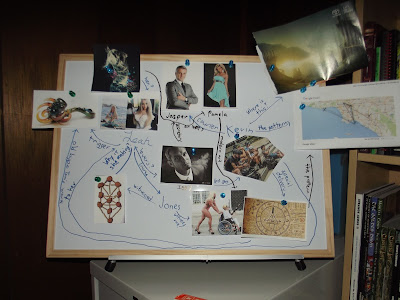I don't have a whole lot to add — his review hits most of the salient points — but I will reiterate a couple of things he mentions.
It's definitely of the new-wave school of narrativism common in a lot of indie games. The rules are simple and the PCs are pretty competent from initial character creation. I understand the initial rules used the roll-and-keep system from Legend of the Five Rings (both being John Wick and AEG, it makes sense), and you can see that system's province here. Roll your dice pool (add a stat and a skill, plus any modifiers, just like new World of Darkness). Instead of looking for a target number, this one uses funky dice math like, say, Wild Talents — you're looking for groups of ten. So, say you roll a 3, 8, 7, 4, 5. You rolled two successes — one 7-3 pair, and one 8-4 pair. (Or 7-4 and 8-5, or whatever). If you have any dice remaining, the GM can purchase them (so that oddball "5" in the above example is fair game) by giving you a plot point. The GM gets to keep those dice in a bonus pool and use them at inopportune times.
It's a neat system, and lets you unpack a lot of data from a roll, but the downside is that interpretation of results (especially if you're trying to avoid giving the GM dice — in the above example, you could avoid this by using 3-4-5 as a set and 7-8 as a set) can take a little while as you're studying handfuls of dice. (I think T. S. Eliot said it best when he said, "I will show you fear in a handful of [dice].") This is probably the sort of thing that would get quicker as you go, though.
And then there's dueling.
One-on-one fights are hard to model in RPGs; by necessity, one character is dueling while the others are watching, and watching stuff happen for a long time is death in an RPG. (Most RPGs don't really do one-on-one fights — D&D, for example, usually models skirmishes and a lot of the higher-level enemies are too potent to take on solo.) Optimally, you want to make duels a psychological, collaborative effort, or otherwise make them tense and fun to watch while being quick to resolve. Most games that come to mind (Deadlands and Legend of the Five Rings, for example) try the latter. This game does neither — the example duel is a long, unwinnable slog in which the other PCs are not to interfere. (The PCs are supposed to win it, but Nicole played the duelist and didn't win, and we know another person who played the duelist in the quickstart and didn't win.)
The big problem comes down to enemy stats. PCs can cut through hordes of enemies, because dealing a point of damage to a Brute Squad (that is, getting a single success on your attack roll) takes out a guy. Since big dice pools can easily hit five to ten successes, taking out a horde of mooks in a round is relatively straightforward. Villains, however, have hit points that scale with their level — so a level three villain is going to effectively have nine hit points (3×3), a level four villain will have sixteen (4×4), and a level eight villain will have sixty-four (8×8). (Most of the PCs in the quickstart had somewhere in 15 to 20 range, if I recall.) This, by the way, represents generic dangerousness — a level 8 villain who is a potent and skilled manipulator surrounded by a web of intrigue and a network of contacts has the same 64 hit points as a level 8 villain who is a swaggering brute of a man bristling with pistols and axes. (I suppose the difference in a duel is that the manipulator probably doesn't have a lot of melee experience.) Sixty-four hit points is a bit of a slog, but appropriate for a group as three to five swashbucklers gang up on one unfortunate bastard. But one-on-one combat between two relatively evenly matched opponents? All else being equal, 64 hit points are going to outlast 20 hit points. Maybe you're supposed to game the system in a way that the fight is winnable, or maybe you're not supposed to give the GM so many plot points that he makes everything difficulty 15 (oops), but I'm not sure how much it would have helped. (I mean, I was playing the Fate-witch, and I gave the duelist +5 dice to all swording rolls during the duel. It didn't help.)
Arashi and I were talking about possibly translating villains' dramatic wounds into a different system in a duel — so instead of the 8×8 scheme for a level 8 villain in group combat, maybe he just has eight hit points, or sixteen.
It's not all complaints and bad news, though. The game really models the narrative in the way a lot of modern indie games do. Characters start out quite competent, and as with a lot of modern games, if all you have is a hammer, any situation can be a nail. (I'm pretty sure I took out mooks by flirting at one point, because my combat stats were low.) Fixing the rough spots would let the system do exactly what the authors want with it, and as with so many things, experience with the system likely speeds it in play.
